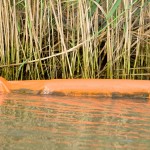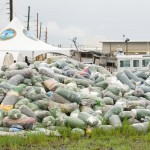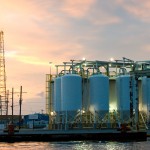You are here
CDC Staff Respond to Oil Spill
Reposted from CDC Connects, Kathy Nellis, CDC
Trudging through the oil-stained sand of a small Gulf Coast island during stifling heat is all in a day’s work for National Institute for Occupational Safety and Health (NIOSH) staff who are part of CDC’s response to the BP Deepwater Horizon oil spill.



Several intrepid scientists recently visited West Ship Island, a barrier island off the coast of Mississippi. Sherry Baron, MD, MPH, and Steve Wurzelbacher, PhD, CPE, who are both from Cincinnati, and who both work with the NIOSH Division of Surveillance, Hazard Evaluations and Field Studies, boated over to the site, part of Gulf Island National Seashore, to check out the oil damage. Hurricane Camille roared through in 1969, pounding the sandy land mass into two sections—West Ship Island and East Ship Island.
The oil from the BP spill is just the latest problem for the popular tourist spot and birds nesting on the soft sand beaches. But the pair are not there to enjoy the view or to check on the abundant wildlife. They are concerned about the workers laboring in the sizzling summer sun, workers whose job it is to stoop and scoop up the tar balls coating the sandy shore. It’s backbreaking, tedious work, in soaring temperatures.
Baron, a medical officer in the Surveillance Branch, and Wurzelbacher, a research industrial hygienist in the Industry Wide Studies Branch, have come armed with new kinds of tools for the workers to test. But mainly they are surveying workers and evaluating health hazards.
Sherry Baron Also Worked on World Trade Center Disaster Response
Baron is just one member of several CDC teams who were collecting data in response to a request by BP for a health hazard evaluation of onshore workers. “Each team had a medical epidemiologist and an industrial hygienist. As the medical epidemiologist, I was responsible, together with my team’s IH Steve Wurzelbacher, for selecting, contacting and collecting survey data from a sample of on-shore workers. Our team was responsible for the beaches and barrier islands around Biloxi and Gulfport, Mississippi.”
It was different from day-to-day work in Cincinnati, she notes. “Working in extremely hot/humid conditions (while wearing full protective gear) was clearly a challenge. However, the major challenge was the nature of the assignment. We were given a map, a stack of surveys and some contact names and were told to come back with a reasonably representative sample of onshore clean-up workers, covering about 35 miles of beaches (all in about one week). We weren’t given much more guidance than that. So it was challenging but also a lot of fun to try and solve the puzzle of how to accomplish that. In the end, we came back with 500 surveys and an 80 percent response rate.”
It was rewarding to be able to successfully complete the assignment, she says. “We had a lot of good luck, including good weather, extremely cooperative field contacts, and a great logistics support staff back at the Mobile Command Center. Without all of those things we would not have been able to do our job. One of the great things about working at CDC/NIOSH is the tremendous sense of teamwork and this assignment allowed me to truly appreciate how great it feels to be part of that team. It was also very rewarding to be able to get to know the workers involved in the cleanup. In order to collect our surveys we spent hours sitting under the rest/break tents, talking to workers. It was interesting to hear their perspectives on their work and on the impact of the oil spill. We were struck by how diverse the workers were, especially since the economic crisis and rising unemployment rate meant that a wider diversity of workers were doing this job than we usually see in similar manually intensive jobs, like among construction workers.
It’s not the first time Baron has been involved in such a massive response. “I was very involved in NIOSH’s efforts following the 9/11 WTC disaster. I was at the initial response following the event and then worked over the subsequent several years assisting with the development of NIOSH’s medical screening and treatment program for the responders. This had some similarities to that event but was also very different. Both disasters involved large numbers of responders and a complex Incident Command Center structure and coordination across a variety of organizations and government agencies. However, there were also some clear differences. The sense of urgency during the WTC disaster associated with a rescue and recovery operation when the lives of thousands were at stake gave that disaster response a clearer and more immediate sense of the tragedy.”
Baron, who started at NIOSH as an EIS officer in the class of 1988, says she really enjoys the sense of collaboration and teamwork at NIOSH. “As with this assignment I really feel privileged to have a job where I get to spend time talking to a wide range of workers about their jobs. I find that all workers have a tremendous sense of pride about their jobs, and it is tremendously rewarding to be able to work with them to develop ways to make their work safer and less stressful.”
No Man Is an Island: Steve Wurzelbacher—Part of Team Surveying Oil Spill Workers
Wurzelbacher was also part of the CDC/NIOSH health hazard evaluation (HHE) of offshore and onshore response workers requested by BP. “I helped as part of the onshore team to collect symptom questionnaires from workers involved in onshore activities; things like shoreline/marsh clean-up; equipment and vessel decontamination; wildlife rehabilitation; waste management; and then evaluate these processes with industrial hygiene observation forms.”
Onshore activities are being conducted in a wide geographic area from Louisiana to Florida, he says, so logistically it was challenging to contact beach workers and administer the questionnaires. “We worked long hours and in extreme conditions of heat/ humidity. It was rewarding to gather input from workers performing the onshore activities in an effort to ensure their health and safety. It was very interesting to meet the wide variety of folks involved and learn a bit about them.”
Wurzelbacher has worked with NIOSH for the last three years and before that from 1999-2001. His favorite thing about his job is “the opportunity to put research into practice to improve the health and safety of workers.”
Gayle DeBord: Everybody Wants to Help
Joining her NIOSH Cincinnati colleagues on West Ship Island is Gayle DeBord, associate director for Science, Division of Applied Research and Technology. She’s been at NIOSH for 23 years, doing things like toxicology and biomonitoring—measuring someone’s exposure to hazards using blood or urine. Her job at the Incident Command Center in Mobile is to support the field teams.
“The people out in the field are amazing. They put in 12-hour days in the hot sun and all kinds of uncomfortable conditions. For me, working in the Command Center is not really hard; it’s the long, long hours and the noise. I feel like I am in a casino. There are so many people milling around and it’s easy to get disoriented and lose track of the days. What day of the week is it anyway?”
The rostering effort is really important, she says. “We are trying to keep track of every worker and of volunteers too. Besides health issues down the road, there could be ergonomic issues too. People are bending over and don’t always have the best tools to use—the postures are often awkward. So for me, this is very rewarding work. What I will remember most is the camaraderie in the command center. And how everybody just pitches in to get things done and keep workers safe.”
DeBord already sees promising results from BP’s request for NIOSH to help. “Last night we visited a boom repair facility and watched the workers. They were working with solvents with latex gloves on. That’s not right. Solvents will go right through latex so we recommended changing to a different type of glove. Being on-site provides opportunities for us to make good recommendations on the spot. And we are continually doing health hazard evaluations.”
DeBord deployed to Texas after Hurricane Ike. “I was at College Station and there was definitely more stress there. We were taking care of nursing home patients at the arena and since they needed so much care, there was simply no down time. And the infrastructure was so damaged. It’s different here. The infrastructure is in place and even though we work really long hours, the immediate impact on human health is not the same. It’s also great that so many people want to help. At NIOSH it seems just about everyone was volunteering for rostering, from scientists to secretaries, everybody wants to help.”
James Durant: Addressing Community Concerns about Health and Safety Issues
Environmental Health Scientist James Durant, MSP, is from Agency for Toxic Substances and Disease Registry (ATSDR) in Chamblee, GA, in the Division of Toxicology and Environmental Medicine, Prevention Response and Medical Support Branch. He served as a technical specialist to the Environmental Protection Agency during the Deepwater Horizon oil spill response. He was based at the Incident Command Center in Mobile, a bustling building filled with close to a thousand people, representing various agencies. It’s a 24-hour operation, staffed with state troopers, military personnel, government workers and more. You see staff from the Army and Coast Guard, CDC, FDA, NOAA, EPA, OSHA, BP staff and many others. Durant attends public meetings to address community concerns about air quality and other environmentally-related health issues.
“Is it safe to breathe the air? Is it safe to let kids swim? What’s going on with seafood? A lot of the concern can be addressed by educating the community, by sharing the data,” Durant said. “For example, data show that, for most people, brief exposure causes no harm, but we still don’t want them picking up tar balls with their bare hands. We try to be empathetic and sensitive to what they are feeling. This is their community.
“We let them know we are doing lots of testing of the air, the surface water, sediment, weathered oil, etc. The tests are done every day in five to seven locations so we can see the trend. When I got here, there were 45,000 people in the field for the response and 6,000 vessels, so it’s a huge public health mission, all unified and connected,” he said.
The Incident Command Center in Mobile is filled with maps, charts, graphs, and flat screen monitors showing oil pulsing into the Gulf from the rig. There is a cacophony of sounds: ringing phones, fax machines, the buzz of people talking, the hum of busy people dedicated to the task at hand. There are conversations about waste management, about how to pick up oil but not the sand, about how to reuse the oil.
Recovery, recycle, reuse is the mantra. Disposal is the last option. Workers are looking for ways to reuse materials coming off the beaches. Meantime, Durant and others are managing critical issues and getting the messages out. Data are compiled and sent to CDC every day.
Durant says it has been rewarding to see the level of effort from everyone involved. “From corporations to our partner agencies, everyone is busting it.”
Lisa Delaney: We Still Have a Long Way to Go on the Response
Lisa Delaney MS, CIH, (LCDR, USPHS) is deputy associate director of the NIOSH Emergency Preparedness and Response Office in Atlanta. She has been helping to coordinate NIOSH response efforts in the Gulf and also deployed to Mobile as the NIOSH team lead to coordinate NIOSH rostering activities in Region IV. “As part of the Gulf response, I have helped draft information documents, coordinate document clearance, lead calls with the NIOSH field teams, lead pre-deployment briefings for field volunteers, and represent NIOSH on various inter-agency calls.”
She was working in the Incident Command Post when news arrived that the well had been capped. “This was the first time in 85 days that oil was not leaking into the ocean. A loud cheer erupted from a small group within the Operations Section. However, most everyone else continued with their work with little more than a smile. It showed to me that we still have a long way to go on the response, but also demonstrated the dedication of the command staff who remained focused on their daily work, despite the exciting news.”
Delaney, who has been with NIOSH 11 years, recalls her work on another big disaster response. “I responded to the September 11th attacks out of a conference room in the basement of Building 101 at Chamblee campus. To say things have changed since those days is an understatement. A much better system is in place for communicating our activities up to HHS and other federal agencies. For this response, we have been able to borrow equipment (GSA vehicles, blackberries, GPS units) from the Emergency Operations Center. These resources weren’t available ten years ago.”
Amia Downes Enjoys Public Health in its Purest Form
Amia Downes, MPH, public health analyst, Office of Planning and Performance, Office of the Director, NIOSH, was deployed to the Gulf region (Alabama and Mississippi specifically) to roster workers participating in the clean-up and response efforts. In last week’s story with John Howard, NIOSH director, he emphasized the importance of rostering. Howard says that a major lesson learned from the attack on the World Trade Center was that there was no list that had the names of workers and volunteers at the site, or had information such as when they were assigned, what they were doing, and when they left. In the Gulf oil spill, it was recognized that the need for such a list was necessary for gathering information on the current impact and future assessment of workers.
Downes is part of that effort. “Besides getting up at 3 a.m., it was challenging to roster workers at vessels of opportunity (VOO) sites, more so than staging areas for beach clean-up workers. After their morning safety briefings, the VOO crews were immediately getting on their vessels to go out and work. So there was not much of a window for those workers to fill out forms, which in turn required both creativity and flexibility in regards to how the rostering process took place at those sites. Plus, many of the VOO sites had multiple launches a day.”
By far, the most rewarding aspect of working in the field during this response was interacting with the workers, Downes says. “Listening to their stories and concerns, as well as providing them with information and guidance as it became available. It's truly public health in its purest form, and being part of that was very fulfilling as a public health professional.”
Downes has also worked in other public health responses. “In April of 2009 I worked in the EOC during the H1N1 response. Both working in the EOC and in the field were great learning experiences, but it's always nice to get out in the field and meet people so one can see the faces and hear the stories of those affected firsthand.” She has been at NIOSH for four years, two of those as an Emerging Leader Intern.
Elizabeth Garza: “I Have Never Been Part of an Environmental Disaster Response Affecting So Many of Our Own Citizens in Such a Profound Way”
Elizabeth P. Garza, MPH ( LT, USPHS), is executive assistant to the director at NIOSH in Washington, DC. “For a week in May I served as part of the NIOSH rostering team deployed to various staging locations in Louisiana, Mississippi, Alabama and Florida to roster response workers. Our goal in this effort is to create a record of those who have participated in clean-up activities and a mechanism to contact them about possible work-related symptoms of illness or injury, as needed.”
For two weeks in July she served in the Mobile Incident Command Post as part of the NIOSH Team. “My role at the Command Post was to help prepare the new rostering field teams to have all the information, contacts, supplies and gear they need to deploy to various staging areas along the gulf. We also work with BP and our partner federal agencies to ensure our activities are coordinated to capture the greatest amount of response workers possible.”
It was a challenging, ever-changing job, she says. Working 7-7, 24/7 under a Unified Command System, with 700 responders from multiple agencies in one facility that are all on short-term rotations, things are always changing to include who you report to, the in-processing/demobilization system, and the people you work with.
“The most rewarding part of working in this response was interacting with the clean-up workers and seeing how grateful they were that we were out in the field rostering them, in case there are any future adverse health effects that develop from this clean-up effort. I was also amazed talking to some of these clean-up workers who said they were honored to be part of this effort to clean-up the environment and help rescue all affected animals. Many of them are from the Gulf Coast area and want nothing more than to bring back their fishing communities and way of living. It was also great to be able to use my Spanish with the large number of Hispanic workers who spoke little to no English, to help answer any questions or concerns they had on our survey.”
Garza has deployed to Iraq and Afghanistan working with these countries to help rebuild the public health infrastructure, but says, “I have never been part of an environmental disaster response affecting so many of our own citizens in such a profound way.”
Virginia Lutz: I Can’t Forget About the 11 Workers Who Died
Safety and occupational health specialist Virginia Lutz works in the NIOSH Division of Safety Research/Fatality Investigations Team and has been with NIOSH for eight years. “I work in both the Fatality Assessment and Control Evaluation (FACE) and the Fire Fighter Fatality Investigation and Prevention Programs. I investigate line-of-duty fire fighter deaths and specifically targeted occupational fatalities. While I was deployed to the Gulf from June 7–21 and from July 3-16, I participated in the NIOSH worker rostering program.”
The first deployment was the most challenging she says because the rostering program was fairly new at that time. “Contacts and procedures were beginning to form, however, site operations and safety personnel were very guarded and required a more in-depth explanation of who we were and what we were doing.”
